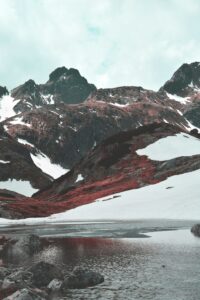Mountain Photographer
In this article :
Being a mountain photographer is not just about capturing snow-covered peaks or misty valleys. It’s about immersing oneself in a rugged, ever-changing, and spectacular landscape, and conveying its essence. Mountain photography is as much about exploration as it is about expression: it demands endurance, technical skill, but also a keen eye for the fleeting details that only the altitude reveals.
It’s no coincidence that mountain images captivate: they evoke escape, the raw power of nature, the unattainable. But behind every shot of a ridge cutting through the sky or mist sliding over the summits, there is a precise gaze, immense patience, and often, a chosen solitude.
A practice between physical immersion and patient observation
Unlike other forms of landscape photography, mountain photographers operate in a constantly changing environment. Temperature, light, clouds, wind, everything can shift in minutes. The hike to the location can take hours, often carrying several kilos of equipment, in extreme conditions. One must be a hiker, sometimes a mountaineer, and know how to adapt to the whims of the terrain.
But this difficulty also strengthens the images. The photographer is not just looking for a photogenic frame; they live the mountain, get lost in it, listen to it. This immersion allows them to capture rare moments where seasons overlap, where shadows fall like curtains on the cliffs, or where frost shapes the stones.
Composing with the vertical element
Mountain photography requires a different way of thinking about composition. Here, horizontality gives way to verticality. The lines of perspective rise, the balances become more dynamic, sometimes unstable. A summit, even from afar, always draws the eye, but one must learn not to make it just a visual totem.
Some photographers work with massive, almost abstract backgrounds. Others prefer to include a tiny human figure facing the vastness. The mountain also allows for a layered narrative: sky, rock, forest, snow, and sometimes… silence.
Unique conditions
The lighting in the mountains is unlike any other. The purity of the air, the altitude, and the reflection on snow or rock create atmospheres that can only be found at these heights. The blue hour is more intense, the shadows sharper, and the backlighting more striking. However, this requires great precision in measuring light and exposure.
One often has to anticipate very brief moments: the fiery glow of a peak at sunrise, a veil of clouds backlit, or a sudden shift into a storm. In these moments, a slight adjustment in aperture or a delayed shutter release can cause the image to slip into oblivion.
A subtle narrative
One of the major challenges in this discipline is moving beyond the postcard. It’s not simply about showing a beautiful place. It’s about telling what’s not immediately visible: the fatigue of the climb, the cold in the fingers, the isolation, the silence.
Some mountain photographers develop a slower, almost documentary approach. They follow the same slope through the seasons, documenting the melting of a glacier, the transformation of a mountain pasture, or how mountain villages adapt to climate changes. Others create a more poetic narrative, relying on shapes, textures, and the repetitions in the terrain.
What are these images for?

Mountain photography finds its place in a variety of contexts:
- Naturalist or travel publications: expedition journals, books about the Alps, the Pyrenees, the Caucasus, etc.
- Institutional or territorial commissions: promoting natural heritage, protecting parks, raising awareness of climate issues.
- Artistic projects: gallery exhibitions, installations in rural areas, mountain residencies.
- Commercial use: tourism, outdoor activities, brands of clothing or mountaineering equipment.
- Personal projects: poetic or introspective storytelling about the relationship with nature and verticality.
Between demand and contemplation
This profession is not something that can be improvised. It requires real mental and physical preparation. But for those who enjoy combining rigor and freedom, observation and immersion, it is a limitless field of expression.
At its core, photographing the mountain means accepting that you can’t control everything. It’s about composing with the unexpected, the weather, the light, the landscape. It’s also, sometimes, spending hours in the cold for just a few seconds of grace. And then leaving, with or without an image, but always transformed.
Jérémy Carlo is the editorial director at Rétines, where he ensures the consistency and clarity of all content produced by the studio.
Our Clients
Let’s discuss
What we do for you at Rétines
Meticulous work, an organised project and fast delivery. And to achieve this, we mobilise the right resources in our teams at the right time.
01
Pre-production
Artistic and technical direction tailored to the project.
Relevant recommendations on content, form and resources.
02
Photo Shooting
Photos taken by our experienced photographers.
Production that’s controlled, efficient and tailored to the needs of the project, with nothing superfluous.
03
Retouching
Technique
Photographs magnified by our retouching team.
Post-production to meet the commercial challenges of the brief.












